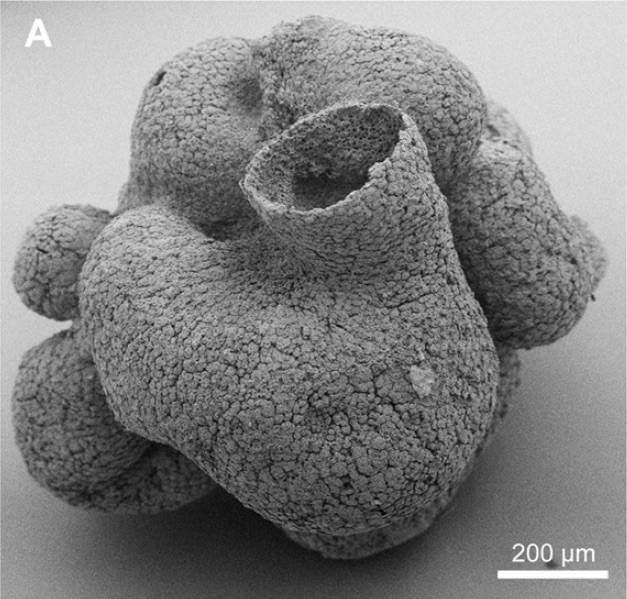A newly published article documenting the discovery of a tiny fossil from Southern China is helping to expand our understanding of the very earliest stages of the evolution of multicellular animal life. (image above is Eocyathispongia. Image from Yin et al 2015.)
The newly-found fossil (Eocyathispongia qiania) is only 1.2mm wide and 1.1mm tall, but even at this nearly microscopic size it still bears the hallmarks of modern sponges. The body is “composed of hundreds of thousands of cells, and has a gross structure consisting of three adjacent hollow tubes sharing a common base.” These hollow tubes end in large openings homologous to the osculum of modern species, and the outer surface of the fossil is composed of a thin layer of flattened cells, which forms an epidermis-like tissue layer that looks quite similar to the pinacoderm seen in many sponge groups today.
The quality of this specimen makes it a truly unprecedented find. There have been sporadic reports of possible sponge-like fossils of similar age, but these specimens were far from conclusive, typically being either spicule-like features in rocks or small cavities interconnected in a sponge-like manner. The importance of Eocyathispongia is that there is no mistaking the nature of this specimen as a card-carrying member of the Phylum Porifera. Its exact affinity within the current classification is uncertain, and the authors leave it placed as an early stem group which shows features of multiple modern groups.
The Doushantuo fossil formation from which this fossil originated has become famous for its remarkably well-preserved microfossils, which reveal morphological features at a cellular level of detail. The fossils are completely embedded within the rock, and can only be studied by dissolving away the surrounding matrix with a weak acid. From these same rocks have come exquisite fossils of ancient multicellular animal (=metazoan) embryos which hint at a diverse ecosystem. There’s even a group of tubelike microfossils that have been described as the earliest known corals.

Crucially, these rocks date to around 600MYA, a period of geologic history where the major groups of metazoan life are thought to have first emerged. This is roughly 50 million years before the famous fossils of the “Cambrian explosion”, making it part of the earliest Ediacaran fauna. In spite of the paucity of early sponge fossils, it has long been assumed that the group dated to well before the Cambrian, and that the lack of fossils was merely an artifact of poor preservation. Molecular data has supported that view, with studies of mutation rates indicating that the earliest branches of metazoan life likely began appearing around 1,000MYA.
The discovery of the morphologically advanced Eocyathispongia lends credence to the idea that sponges evolved long before their appearance in the fossil record, meaning that these early animals would have endured a period of geologic history dominated by the complete glaciation of the earth, the “snowball earth” of the Cryogenian!
This guest contribution was written by Joe Rowlett
References
Liu, Pengju, Shuhai Xiao, Chongyu Yin, Chuanming Zhou, Linzhi Gao, and Feng Tang. 2008.Systematic Description And Phylogenetic Affinity Of Tubular Microfossils From The Ediacaran Doushantuo Formation At Weng’An, South China. Palaeontology 51.2: 339-66.
Yin, Z., Zhu, M., Davidson, E. H., Bottjer, D.J., Zhao, F., Tafforeau, P., 2015. A sponge grade body fossil with cellular resolution dating 60 Myr before the Cambrian. PNAS.



